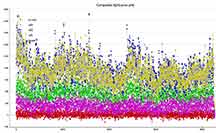

Based on recent experience, I'm going back to using an estimate "Watec magnitude W" which is halfway between the V and R magnitudes, as the best magnitude for reference. This is a high rank event passing through Santa Cruz and Capitola, not visible for Karl at home, but at Cabrillo Observatory inside the path. Kirk is also south of the path, but at the Eco Reserve on Martin road that is good. I've set down a marker at the Upper UCSC Meadow bike crossing.
The event 20 minutes earlier is just too hard to try and get with our 8SE scopes and only the 12" Scope at Cabrillo would have a chance at that, but the altitude=20 is too low for it to be possible, and besides it's south of the nominal shadow path. And fog would cancel it there - not possible. I'm removing it from the active list.
For Nydegger: Alt=25, Az=158 in the SE. The target is in Sagittarius, on the outskirts of the rich Messier 28 star cluster, far enough outskirts to hopefully not be too crowded, but M28 will be inside the 8SE chip view. It'll make an easy way to get on-target.
 |
 |
Karl did not try, too tough. Kirk tried but had power? troubles and failure to ID the field. I was the only one who got data, but the data is noisy for such a difficult event and the required short 4x for getting the time resolution. It was always a very tough event and only worth the effort if there was a better event soon after, which there was: Brixia, a nice success!
There's a drop at the correct time for this nominally high rank event, but the noise is significant in the light curve, and it will likely be rejected as "unknown" or "unsure". I wanted/needed the time resolution, so I integrated at 4x, but you can see we must have had drifting thin aerosols, in the ref stars and target, all with big waves in the light. PyOTE says a 0.32s event with poor constraints. The sky light curve is at the level of the lowest 3 points of the target light curve.
magDrop report: percentDrop: 100.0 (magDrop cannot be calculated because the histogram for 'sky' was incomplete. A common problem for Watec CCIR cameras). However, by plotting the 'sky' on the final PyOTE plot, shows the mag drop did look to be 100% to within observational uncertainty.
DNR: 2.76
D time: [07:25:44.8092]
D: 0.6800 containment intervals: {+/- 0.0372} seconds
D: 0.9500 containment intervals: {+/- 0.1330} seconds
D: 0.9973 containment intervals: {+/- 0.3633} seconds
R time: [07:25:45.1292]
R: 0.6800 containment intervals: {+/- 0.0372} seconds
R: 0.9500 containment intervals: {+/- 0.1330} seconds
R: 0.9973 containment intervals: {+/- 0.3633} seconds
Duration (R - D): 0.3200 seconds
Duration: 0.6800 containment intervals: {+/- 0.0617} seconds
Duration: 0.9500 containment intervals: {+/- 0.1962} seconds
Duration: 0.9973 containment intervals: {+/- 0.4466} seconds
 |
 |
-t.jpg) |
 |
 |
 |
I got a no-observation for Nydegger.
I aligned ok and got the field in the eyepiece with M28, but when I put the camera in I couldn't recognize the field.
I slewed around to try and find M28 but couldn't. I then entered M28 on the keypad and it slewed way over to the opposite side of the sky.
I did another ra-dec goto and it still went to the other side of the sky.
By then it was too late to do over the two star align and I missed it.
(I've had my scope once in a great while fail spectacularly like this, but I do suspect it was a power glitch. I always snug in my 3 connection points before power-on.... at battery, the male/female 12v connection to the barrel plug, and barrel plug into scope. I've never had the battery connection be flakey, but the 12v plug connection has a spring-loaded center piece that can push on the female side and work itself loose over time. And then there's the Meade vs Celestron barrel connection at the scope. That needs to be diagnosed immediately when you buy the plug, and even then I suppose that frictional wear can eventually cause power loss, or brushing against it during operation. RN)